Inside the fascinating life of the unforgettable Joan Rivers
She was razor-sharp, famously foul-mouthed and occasionally misjudged. But love her or loathe her, you couldn’t ignore her. We look at how this comedy trailblazer – in the public eye for six decades – will be remembered...

She was razor-sharp, famously foul-mouthed and occasionally misjudged. But love her or loathe her, you couldn’t ignore her. We look at how this comedy trailblazer – in the public eye for six decades – will be remembered...
Joan Rivers exits the office of New York dermatologist Patricia Wexler, her regular go-to doctor for Botox and fillers. As she gets down on her hands and knees and crawls into the crowded waiting rooms, she pulls her face into a stroke-like grimace. ‘Look what she did to me!’ mumbles Joan, as the assembled models and socialites look on in complete horror. The prank is pure Joan.
Her humour was unsparing, unapologetic, unadulterated. In a career that spanned six decades, the wisecracking comedian took no prisoners, least of all herself, as she mined her own life for laughs. When she launched onto the New York comedy scene in the 60s, her stand-up routine was no less than ground-breaking in its ferocity. Camille Paglia described her as ‘an iconic feminist role model’. No woman had ever had the balls to tell it like Joan did, and tell it she did, with her trademark catchphrase, ‘Can we talk?’
Joan Alexandra Molinsky (she later took her agent’s surname) was born on 8 June 1933, in Brooklyn, New York, She was ‘a fat, ugly child’ who felt outshone by her older sister. It made her desperate to be smarter and thinner. As a child, she was also attuned to her parents’ strained relationship. Both Russian Jewish immigrants, her father, Meyer, was a hard-working doctor, her mother Beatrice, a housewife who lived beyond her means. (Joan would grow up to be a prodigious spender.)
She first discovered the power of comedy aged eight when she regaled family friends with a funny story and realized they were laughing with her, not at her. Years later, in her biography, Enter Talking, Joan wrote how comedy was ‘a medium for revenge. We can deflate and punish the pomposity and the rejection which hurts us.’
Joan aspired to be an actress, but her parents threatened to disown her, so she took a job at a department store instead. At 22, she married the boss’s son. Five months later, the union was annulled – he didn’t want children and hadn’t told her. Joan returned home to her parents until a row over her acting forced a year-long estrangement – her father, having watched one of her early theatrical endeavours, said the play ‘was the worst piece of garbage I ever saw’. It was a pivotal moment, she struck out on her own, taking any work she could get while auditioning for acting roles (one of her first was playing the lesbian lover of an as yet unknown Barbra Streisand). When Joan heard she could earn more as a comic than as an office temp, she discovered a surprising new métier.
In the early 60s, Joan unleashed her simmering resentment. Her inspiration was the no-holds-barred comedian Lenny Bruce, from whom she learned that ‘outrageousness can be cleansing and healthy’. Starting in seedy strip joints, she hustled her way into clubs where she was the only female performer alongside other wannabes such as Richard Pryor and Woody Allen. No subject was safe from her acerbic wit – abortion, disability, fat celebrities and the Holocaust were all grist to the mill. ‘When I am on stage, I am every woman’s outrage,’ said Joan. ‘I am furious about everything. Every joke I make, no matter how tasteless, is there to draw attention to something I care about.’
Marie Claire Newsletter
Celebrity news, beauty, fashion advice, and fascinating features, delivered straight to your inbox!
Finally, in February 1965, Joan was a guest on The Tonight Show. She left host Johnny Carson in stitches and he told her, ‘God, you’re funny. You’re going to be a star.’ Not only did Carson’s prophecy come true – three years later, Joan was packing out comedy clubs across America and being heralded by The New York Times as ‘quite possibly the most intuitively funny woman alive’ – Carson also introduced Joan to her new husband. ‘I just knew he was absolutely correct for me,’ said Joan, who married TV producer Edgar Rosenberg in July 1965, four days after they first met. ‘He was smarter than I was. And outwardly, he also had what I wanted: manners, the façade, the credentials to walk into any room.’ Controversially, Joan continued to perform while heavily pregnant with daughter Melissa two years later. ‘That was unheard of,’ she said. ‘Every reviewer said I should not be on stage.’
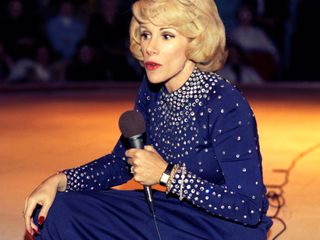
Her bravado belied crippling insecurity. She told one interviewer ‘no man ever told me I was beautiful…no man ever told me I had a good body’. Her solution was plastic surgery. ‘A bad face-lift is better than none at all,’ reasoned Joan, who had two, as well as cheek implants, an eye lift, nose thinning, liposuction and a tummy tuck. ‘I’ve undergone more reconstruction than Baghdad,’ she once quipped.
Joan's career soared through the 70s and into the 80s. She became a permanent guest on The Tonight Show and enjoyed sell-out tours in Vegas, commanding $200,000 for a five-night run. She admitted: ‘I am my work. It’s my drug of choice. I’m afraid the work will dry up.’ Unbeknown to her, that nightmare – and much more – was about to come true.
Although in 1986 she received a $15-million contract to host The late Show Starring Joan Rivers, making her the first woman to have her own late-night talk show on a major network, her supremacy was short-lived. Less than a year later, Joan was told by TV executives to tone down her style and ratings slumped. Behind the scenes, rows led to Fox threatening to sack the show’s producer, Joan’s husband, Edgar. Joan said she’d walk, and in the end, they were both fired. Three weeks later, Edgar – who’d been suffering long-term depression – committed suicide.
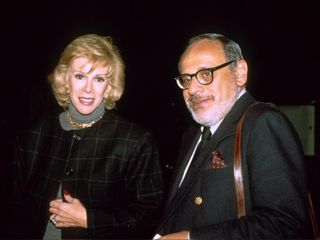
His death almost broke Joan. She became estranged from 19-year-old Melissa for a year (her daughter blamed her for what had happened). She also discovered that Edgar had squandered all their money on bad investments.
Joan sold her Bel-Air mansion and moved to New York. Then the work dried up, nobody wanted to book a woman whose husband had killed himself. As her life began to unravel, Joan became bulimic, though she later recovered with therapy. (Friends recall how when they went out to dinner, she would put mints on the table and eat them while picking at her food.)
At her lowest, she considered suicide. ‘I was a pariah. I was a non-person. I thought, “What’s the point?” recalled Joan, who was saved by her dog, Spike. ‘I had the gun in my lap and the dog sat on the gun.’

She was forced to start again. She took her ‘merry widow tour’ to the tiny clubs where she’d begun, getting booed when she told gags about Edgar’s death. But she clawed her way back and, in 1989, her persistence was rewarded with a new daytime TV talk show, The Joan Rivers Show, which ran for five years and earned her an Emmy award. Three years later, she found love again with Orin Lehman, a former financier who had the use of only one leg (‘my Heather Mills’). After nine years together, she discovered he was seeing other women and she dumped him. For a while, she made a financial recovery with the jewellery range she sold on QVC (when clothes and beauty were added, she pulled in more than $1 billion). She had a lavish lifestyle to fund, including an Upper East Side penthouse that resembled a mini Versailles, and a butler who served guests M&Ms from a silver platter. But she was known for her generosity, paying the school fees for her friends’ children.
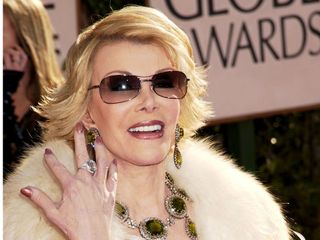
Shockingly, in 1995, another financial disaster loomed when her business partner absconded with $37 million after floating her company, Joan Rivers Inc Worldwide. ‘I’ll work the rest of my life to pay that off,’ she said at the time. Fifteen years later, the documentary Joan Rivers: A Piece of Work showed Joan still haunted by failure. ‘I’ll show you fear,’ she says, staring forlornly at a blank diary. ‘That’s fear.’
‘I was quite intimidated by the idea of Joan,’ says Ricki Stern, one of the film’s directors. ‘But she was much more open and vulnerable than I’d expected. At our first meeting, she sat on a stool looking up at me. It was her way of putting me at ease.’
Joan spent 25 years volunteering for a charity that delivers meals to people with HIV/AIDS. ‘I remember at one delivery there was no elevator in the building,’ says the charity’s Blaine Trump. ‘Joan was dressed to the nines. We walked up seven flights of stairs. When we got to the door, she fell in the apartment and said: “I’ve gotta sit down. Here’s your meal.” She was hilarious.’
After her career hiatus, Joan, at 77, bounced back with a new TV show, Fashion Police, in which she and Kelly Osbourne lampooned celebrity wardrobes at red-carpet events: ‘I say: “Nicole Kidman, you’re in a red dress with a white face. You look like a ketchup bottle.” She won’t talk to me at the next part, but that’s my job.’
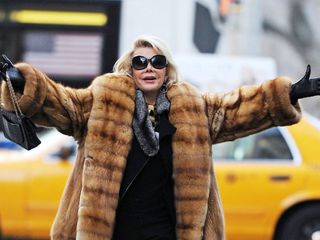
Four years later, Joan made possibly her most controversial comment yet when she respond to 2,000 Palestinians being killed in the Israel-Gaza crisis: 'They were told to get out. You don’t get out, you’re an idiot. At least the ones killed were the ones with low IQs.' She later said her comments had been taken out of context and a statement said she was ‘praying for peace’.
She seemed unstoppable. Asked if she’d ever retire, the 81-year old shot back: ‘I’d rather die.’ A month later, she stopped breathing during a minor throat operation. She remained on life support until her death on 4 September 2014.
‘She was so funny, smart, kind and likeable, you couldn’t not fall in love with her,’ says Ricki Stern. ‘The small shows where she’d test out jokes was when you saw her brilliance. Laughter was her oxygen.’
The leading destination for fashion, beauty, shopping and finger-on-the-pulse views on the latest issues. Marie Claire's travel content helps you delight in discovering new destinations around the globe, offering a unique – and sometimes unchartered – travel experience. From new hotel openings to the destinations tipped to take over our travel calendars, this iconic name has it covered.
-
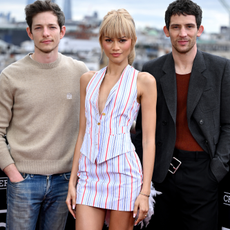 Zendaya's reaction to awkward kissing question during Challengers interview has gone viral
Zendaya's reaction to awkward kissing question during Challengers interview has gone viral'Uncomfortable' doesn't begin to cover it
By Iris Goldsztajn
-
 Prince William feels 'immense responsibility' amid Kate and Charles cancer diagnoses
Prince William feels 'immense responsibility' amid Kate and Charles cancer diagnosesHe has a lot on his plate
By Iris Goldsztajn
-
 Taylor Swift just teased a 'timetable' for her new album release
Taylor Swift just teased a 'timetable' for her new album releaseThe wait is torture
By Iris Goldsztajn